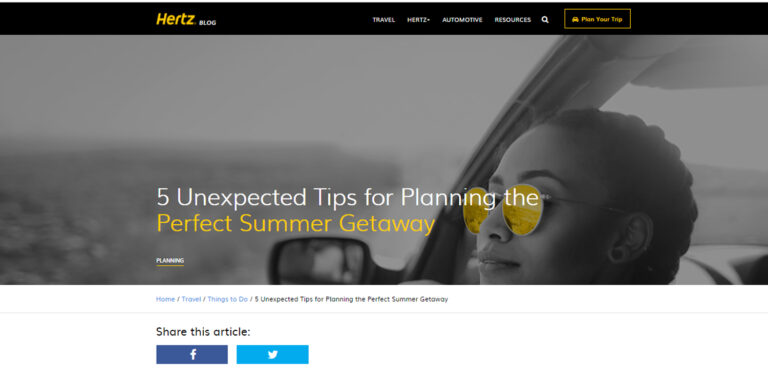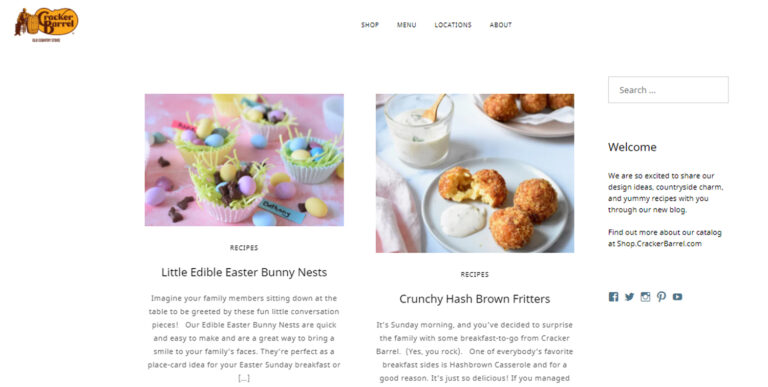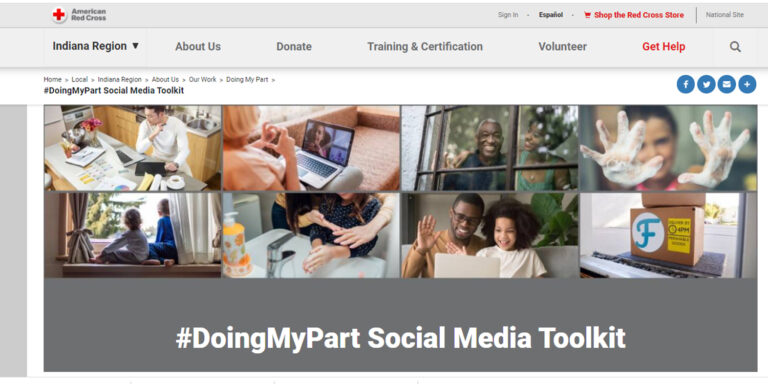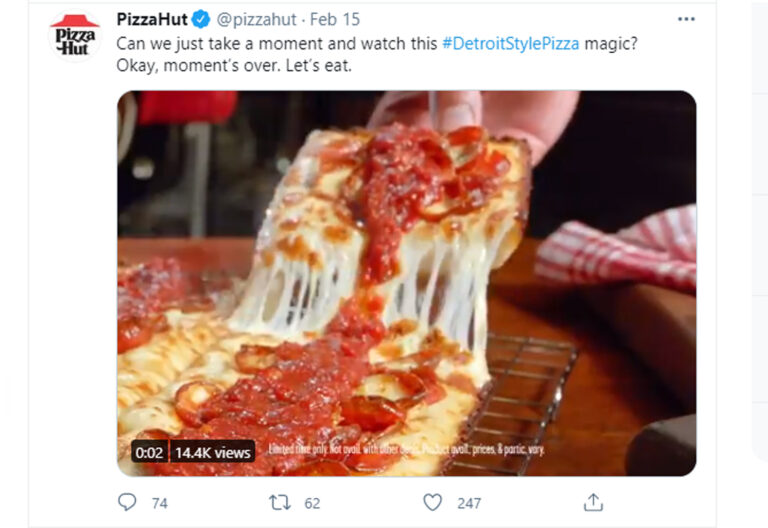AFFILIATE MARKETING
11 Stellar Content Marketing Examples to Inspire Your Digital Marketing Strategy

Content marketing gives you the opportunity for optimal keyword placement and provides tons of information that search engines can scan to help you earn higher rankings.
All of this leads to higher visibility, brand awareness, and more traffic to your site.
About 60% of marketers value content as very or extremely important to their business success.
But only 27% of them feel their efforts are very or extremely successful.
That’s because content marketing isn’t easy.
It takes time, research, and focus to create meaningful material that resonates with an audience.
The good news is that content marketing is a huge category, so there are lots of ways to deliver the kind of quality content it takes to drive sales.
Here are 11 outstanding content marketing examples from individuals and organizations who have mastered the art of content marketing.
Follow their example to learn how to develop your own inspirational content that generates leads and earns sales.
Blogs With Impactful Content Marketing Strategies
1. GaryVaynerchuk.com

Gary Vaynerchuk climbed to internet stardom as the zany host of video blog Wine Library TV.
Now, he’s a two-time best-selling author and the co-founder of Vayner Media, a digital marketing agency that caters to some of the world’s biggest brands.
On his website, Vaynerchuk releases an authoritative blog article once every three to four days.
His posts lead with splashy cover images that draw the eye, and the compelling information covers everything from how-to guides to educational introductions for new services and products.
While many of his articles now relate to his marketing business, he still posts articles for his wine lovers.
As a result, he’s got a great mix of content to meet the various needs of his diverse audience.
His videos, podcasts, and useful articles (chock full of backlinks and helpful takeaways) attract prospects, engage readers, and entice them to convert to customers.
2. The Home Depot Blog

The Home Depot blog is a brilliant example of content marketing, and here’s why.
First, everyday people who enjoy and have experience with home improvement projects contribute as guest writers and post-project tips and ideas on the blog.
Not only are they relatable, but they also create content based on first-hand experience, so readers trust them.
In addition to providing useful content, the Home Depot blog posts are full of links to products in their stores that help readers complete the projects covered in the blog.
So they’re not just building a following with their content.
They’re crushing SEO with keywords, links, and a convenient user experience.
By leading readers directly to useful items on their company website, they drive sales and conversions on a daily basis.
3. Hertz Travel Blog

While most people know Hertz as a leading car rental company, the Hertz Travel Blog is an added value for their audience.
From experienced international travelers to the occasional leisure traveler, members of the Hertz blog target audience can find highly useful information to help plan their trips.
While some posts do mention car rental services, the bulk of their content ranges from insider tips for making the most of hotel stays to can’t-miss sight-seeing excursions for the traveler on a time crunch.
Articles and videos dive into immersive storytelling that engage their audience and appeal to their sense of adventure and preparedness.
Hertz makes sure their articles are highly sharable, always featuring large social media link buttons at the top of each post.
This makes it easy for readers to pass the information along to their own contacts, broadening the company’s reach and increasing brand awareness.
4. Cracker Barrel Blog

Cracker Barrel is known for its down-home cooking and old-fashioned mercantile complete with clothes, memorabilia, and retro treats.
Their audience is interested in anything from their food to their holiday décor, so it takes some clever messaging to appeal to their followers.
The Cracker Barrel blog is a simple layout that highlights a variety of articles to reach the needs of everyone they touch.
Their recipe articles feature links to branded food items people can purchase from the store.
Holiday decorating tips include products they sell and direct customers where to buy them.
Not only is their information helpful and useful, but it’s also great for SEO and search engine rankings.
Cracker Barrel’s blog presents lots of opportunities for visitors to convert and generate revenue for the company.
Social Media Content That Converts
5. American Red Cross #DoingMyPart

The American Red Cross developed a tool kit complete with messaging suggestions and image options for their #DoingMyPart social media campaign.
It encouraged people to post photos of themselves on their social media accounts doing things to help stop the spread of the Coronavirus while tagging their posts with the campaign hashtag.
While the organization thought people might post images of themselves washing their hands, wearing face masks, or donating blood, the campaign took on a life of its own.
People on Twitter began posting more creative ways they were helping in the fight against the virus, flooding the network with photos of themselves manning COVID-19 call centers and receiving vaccine injections.
By encouraging their followers to personalize corporate messaging and create user-generated content focused around a timely topic, the Red Cross boosted engagement, awareness, and conversions.
6. Starbucks SipSmileSpring
To promote their new spring line of drinks, Starbucks created an interactive game on their Instagram account called SipSmileSpring.
In the game, users control gameplay by simply smiling at the right time.
Not only is it a fun way for Starbucks to engage its audience but they encourage people to share the post, tag Starbucks and earn the opportunity for their video to be featured on the brand’s page, as well.
This builds brand awareness and engagement in a highly creative way.
Because of the idea’s novelty, the campaign earned over 79,000 views in the first two hours of going live.
7. Levi’s 7 Days 7 Ways
The renowned jeans brand used their Instagram page to create a social challenge called 7 Days 7 Ways.
Promoting sustainability and asking people to reject fast fashion, Levi’s asked people to style their favorite Levi’s jeans with a different look each day for a week.
They felt this would entice people to wear their jeans more frequently between washes and increase the lifespan of the product while helping the environment.
Followers posted pictures of their styles and tagged the company, raising brand awareness and creating a sense of community as they inspired others with fashion recommendations and social awareness.
Visual Content That Motivates Consumers to Buy
8. Pizza Hut

Focusing heavily on imagery in their marketing campaigns, Pizza Hut’s emails and social media posts are filled with tantalizing product photos.
Steaming hot pizza, cheesy toppings, and crispy crusts all appeal to the senses of its audience.
The photos create buzz on social media and earn them sales through mobile ads and email campaigns.
They do a great job of telling a story through the photos they post while generating interest and showing how their product is superior to their competitors’.
9. Kendra Scott

As a leader in women’s jewelry, home décor, beauty, and gifts, the Kendra Scott brand knows the importance of visual impact.
The company features beautiful product shots in its marketing campaigns that grab viewers’ attention and identify features that make the products unique.
Kendra Scott also uses photos to recommend product use, showing consumers how to wear their items to meet the latest trends and create unique looks to show off users’ individuality.
The pictures don’t even need words to convey their message, which is a sign of an effective visual content marketing campaign.
Effective Video Content Marketing Examples
10. Tasty

One frustration consumers have is when words fail to adequately describe a product or process.
Tasty is a network for food lovers where people can find recipes and learn cooking tips and tricks.
Their marketing focuses heavily on the use of well-executed videos of someone actually making a recipe.
Their upbeat, aerial-view videos offer a step-by-step demonstration of combining ingredients and cooking the food, eliminating any question about misinterpreting the recipe instructions.
The videos are extremely popular and offer a forum for people to leave comments and share feedback about the recipe, its ingredients, and the video itself.
More than a simple instructional video, Tasty’s marketing campaign educates and connects a community of like-minded people, making it an invaluable resource that people are happy to share with their own contacts.
11. Sunny Paige

Although they’re a small-town boutique, Sunny Paige uses Facebook live videos in a big way.
Each week, the business hosts a live session from their store to present their current featured items.
Staff members take viewers through the store and model clothing and accessories while explaining the key traits of each item.
Everything is conducted in a very laid-back, conversational way, as though they’re talking to their personal friends.
This builds trust among their prospects and generates interest in their products and their shop.
By including these live videos in their marketing strategy, Sunny Paige is able to address questions about fit, material, and price that build confidence among their viewers and encourage them to commit to a purchase.
Content Marketing Is a Must for Any Marketing Strategy
Whether you use blogs, social media, or videos, content marketing is a must for any digital marketing strategy.
It allows you to connect your audience to your products, positions you as an authority in your field, and helps to boost SEO efforts for better SERPs.
Think outside the box for fun, creative ways to set yourself apart from your competition while serving as a resource for your audience.
Image Credits
All screenshots taken by author, March 2021
AFFILIATE MARKETING
AI Will Transform the Workplace. Here’s How HR Can Prepare for It.

Opinions expressed by Entrepreneur contributors are their own.
Our workplaces are about to undergo an unprecedented level of transformation, and HR will take center stage. Artificial intelligence will dramatically reshape HR in a way that goes beyond recruiting, hiring and talent management. Leadership teams at all levels need to embrace this change to transform and lead their organizations forward.
It’s the people, and not the technology, that makes AI initiatives a success. Intrapreneurs, in particular, are the driving force behind it. As I shared in Fearless Innovation, I noticed this when I was working on the innovation agenda for the Great Places to Work study — the most innovative companies were those that had a leadership team that was embracing intrapreneurship and were open to change.
HR is the beating heart of any organization, and as such, it needs to take center stage in both adopting and leading ethical and innovative AI transformation across the organization.
Related: How Artificial Intelligence Is Reinventing Human Resources
4 tectonic shifts AI will drive in HR
1. A new wave of massive reskilling
As AI becomes more prominent across business functions, the need for new skills will only grow. Forty percent of enterprise leaders believe that their workforce would need to reskill as a result of AI and machine learning. In fact, research shows almost a third of all hours worked in the U.S. could be automated by 2030.
All of us need to reskill to some extent to be relevant in the AI era. Not only would people need to re-train, but generative AI is introducing a whole host of professions that have been non-existent until recently, from AI ethicists to human-AI interaction designers. Some of these roles might sound futuristic, yet they are becoming increasingly relevant as technology advances.
2. The great restructure
As automation takes center stage across more business functions, there will be the inevitable need for organizations to restructure and rethink how they work. This transition will not only involve the integration of new technologies but also introduce a shift in the workforce dynamics. Intrapreneurs will need to identify gaps both in skills and operational processes and forge brand-new roles for themselves and those they manage. HR must play a key role in enabling a smooth and easy transition in this regard. The transition will not be smooth or easy, and it’s only HR that has the capability to make it impactful.
3. Arrival of “digital humans”
“Digital human” may sound like an oxymoron, but that’s the term that’s starting to appear in business and operational plans. More roles, regardless of industry, are becoming digitally enhanced where some form of AI assistance is embedded in their everyday work. A real-life example is the introduction of the digital nurse — AI-powered healthcare agents which have already been proven to outperform human nurses in certain tasks.
Imagine the impact these digital roles will have on the workforce the more sophisticated and prevalent they become. Eventually, HR will need to create policies and systems in place that account for this new type of “staff augmentation.”
4. Regulating the robot
The threat of AI bias and misuse is serious. Not only can the technology put many jobs at peril, but potential improper implementation can expose organizations to serious liability and negatively affect the workforce. From avoiding bias to inclusivity, HR teams play a critical role in the ethical deployment and management of AI technologies.
HR professionals will be tasked with navigating the delicate balance between leveraging AI for efficiency and ensuring that its application upholds fairness, privacy and non-discrimination.
What HR intrapreneurs must do to embrace AI the right way
The future of work is being shaped by AI adoption, and its success hinges on the right approach from the outset. My experience shows that for successful organizations, one universal trait stands out: the presence of change agents. Every organization, regardless of size, benefits from intrapreneurs who are open to change and committed to spearheading transformation efforts. These intrapreneurs are pivotal in driving the future of work, as they help orchestrate the integration of new technologies into their business models.
HR and talent leaders should harness this dynamic, encouraging a symbiotic relationship with intrapreneurs to develop customized solutions for AI adoption, ensuring that they are not just keeping pace with technological advances but are actively shaping their trajectory.
Securing a seat at the table:
HR should take a proactive stance in the adoption of AI, even if it is still in its early stages within your organization. By securing a position at the forefront of the AI initiative, HR can and should facilitate and guide the entire organization in embracing this significant change.
As AI has the potential to impact every facet of the organization, it is imperative for HR to not only understand and advocate for this technology but also lead its integration across all departments. HR should encourage and support intrapreneurs and all employees to leverage AI in their daily tasks, demonstrating its value not just for operational efficiency but for personal and professional growth as well.
Master the technology:
To effectively navigate and regulate AI, HR must first understand it thoroughly. Grasping the full potential of this technology is crucial for reaping its extensive benefits. HR plays a vital role in identifying the necessary tools and skills that employees must acquire and then integrating these learnings into daily work practices.
Before implementing AI more broadly, HR should initiate comprehensive training programs that not only educate but also reassure employees about AI’s role in the future of the business. By leading these educational initiatives, HR can shape the structure and effectiveness of these programs, ensuring they meet the needs of the organization and its workforce.
Related: 3 Ways to Prepare Your Business For an AI Future
Looking ahead
Generative AI has the transformative potential to redefine the business landscape, but realizing this vast potential hinges on more than just the adoption of technology. It critically depends on the talent within the workforce, driven by HR and bold intrapreneurs. These visionary leaders don’t just implement new tools; they exemplify their use, demonstrating the profound impact of AI across every level of the organization.
HR plays a pivotal role in fostering this environment, enabling intrapreneurs to guide and inspire every individual they touch. Together, they turn each employee into a catalyst for change, igniting a widespread passion for innovation that deeply resonates and sustains long-term success.
AFFILIATE MARKETING
Samsung: 6-Day Workweek For Execs, Company in Emergency Mode

Four-day workweeks might have all the buzz, but one major tech company is going in the opposite direction.
Samsung is implementing a six-day workweek for all executives after some of the firm’s core businesses delivered lower-than-expected financial results last year.
A Samsung Group executive told a Korean news outlet that “considering that performance of our major units, including Samsung Electronics Co., fell short of expectations in 2023, we are introducing the six-day work week for executives to inject a sense of crisis and make all-out efforts to overcome this crisis.”
Lower performance combined with other economic uncertainties like high borrowing costs have pushed the South Korean company to enter “emergency mode,” per The Korea Economic Daily.
Related: Apple Is No Longer the Top Phonemaker in the World as AI Pressure and Competition Intensifies
Executives at all Samsung Group divisions will be affected, including those in sales and manufacturing, according to the report.
Samsung had its worst financial year in over a decade in 2023, with the Wall Street Journal reporting that net profit fell 73% in Q4. It also lost its top spot on the global smartphone market to Apple in the same quarter, though it reclaimed it this year.
Though employees below the executive level aren’t yet mandated to clock in on weekends, some might follow the unwritten example of their bosses. After all, The Korea Economic Daily reports that executives across some Samsung divisions have been voluntarily working six days a week since January, before the company decided to implement the six-day workweek policy.
Entrepreneur has reached out to Samsung’s U.S. newsroom to ask if this news includes executives situated globally, including in the U.S., or if it only affects employees in Korea. Samsung did not immediately respond.
Research on the relationship between hours worked and output shows that working more does not necessarily increase productivity.
A Stanford project, for example, found that overwork leads to decreased total output. Average productivity decreases due to stress, sleep deprivation, and other factors “to the extent that the additional hours [worked] provide no benefit (and, in fact, are detrimental),” the study said.
Related: Samsung’s Newest Galaxy Gadget Aims ‘To See How Productive You Can Be’
Longer hours can also mean long-term health effects. The World Health Organization found that working more than 55 hours a week decreases life expectancy and increases the risk of stroke by 35%.
The same 55-hour workweek leads to a 17% higher risk of heart disease, per the same study.
AFFILIATE MARKETING
John Deere Hiring CTO ‘Chief Tractor Officer,’ TikTok Creator

This article originally appeared on Business Insider.
Agriculture equipment company John Deere is on the hunt for a different kind of CTO.
The brand on Tuesday announced a two-week search to find a “Chief Tractor Officer” who would create social media content to reach younger consumers.
One winning applicant will receive up to $192,300 to traverse the country over the next several months showcasing the way John Deere products are used by workers, from Yellowstone National Park to Chicago’s Wrigley Field and beyond.
“No matter what you do — whether it’s your coffee, getting dressed in the morning, driving to work, the building you go into — it’s all been touched by a construction worker, a farmer, or a lawn care maintenance group,” Jen Hartmann, John Deere’s global director of strategic public relations, told AdAge.
To kick off the search, John Deere tapped NFL quarterback Brock Purdy (who will presumably be a bit busy this Fall to take the job himself) to star in a clip in which he attempts to set out on a road trip in an industrial tractor.
Suited up in the obligatory vest, work boots, and John Deere hat, Purdy’s progress is interrupted by teammate Colton McKivitz hopping into the cab while a string of messages floods in from other athletes and influencers expressing interest in the job.
The clip also represents the first time that the 187-year-old company has used celebrities to promote itself, Hartmann told AdAge.
According to the contest rules, entrants have until April 29 at midnight to submit a single 60-second video making their pitch for why they should be the face and voice of the company.
In addition, entrants must live in the 48 contiguous states or DC — sorry Hawaii and Alaska residents. Interestingly, any AI-generated submissions are prohibited, too.
Videos will be judged against four categories — originally, creativity, quality, and brand knowledge — after which five finalists will be chosen and notified after May 17.
-

 SEO7 days ago
SEO7 days agoGoogle Limits News Links In California Over Proposed ‘Link Tax’ Law
-

 SEARCHENGINES6 days ago
SEARCHENGINES6 days agoGoogle Core Update Volatility, Helpful Content Update Gone, Dangerous Google Search Results & Google Ads Confusion
-

 SEO6 days ago
SEO6 days ago10 Paid Search & PPC Planning Best Practices
-

 MARKETING7 days ago
MARKETING7 days ago2 Ways to Take Back the Power in Your Business: Part 2
-

 MARKETING5 days ago
MARKETING5 days ago5 Psychological Tactics to Write Better Emails
-

 SEARCHENGINES5 days ago
SEARCHENGINES5 days agoWeekend Google Core Ranking Volatility
-

 PPC7 days ago
PPC7 days agoCritical Display Error in Brand Safety Metrics On Twitter/X Corrected
-

 MARKETING6 days ago
MARKETING6 days agoThe power of program management in martech













